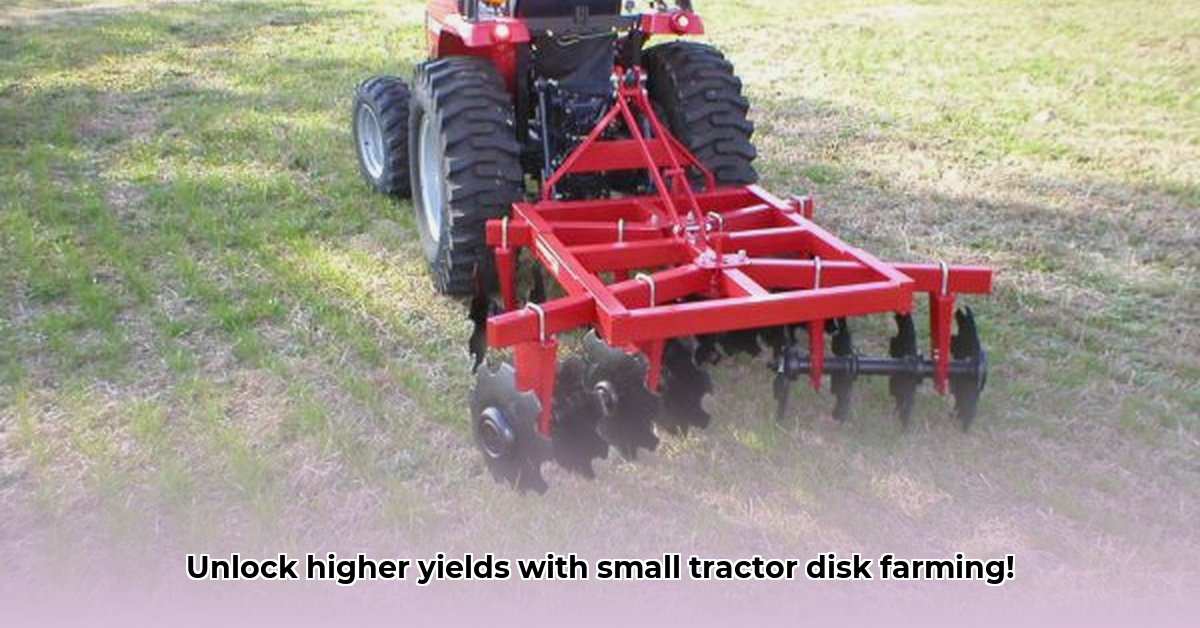
Disk for Small Tractor: Boosting Your Yields Sustainably
Farming is hard work, but what if you could make it easier and more environmentally friendly? A disk for your small tractor can be a game-changer, improving your soil and boosting your harvests. Think of it as a tireless assistant, helping your crops thrive. But how can this relatively simple tool play such a significant role in sustainable agriculture? For more information on compact tractor disks, check out this helpful resource.
Understanding Your Disk
A disk isn't just for tilling; it's about optimal land preparation. The spinning disks slice, mix, and smooth the soil, creating the perfect seedbed. This leads to stronger roots, improved water and nutrient uptake, and a significant head start for your plants. Improved soil structure also means better water penetration, potentially reducing your irrigation needs and helping to conserve water, especially during dry spells. And as a bonus, it can significantly reduce weed growth!
Choosing the Right Disk
Selecting the right disk depends on several factors. Your tractor's horsepower is crucial – too little power and you'll struggle, too much and you risk damage. Consider your field size (a wider disk covers more ground faster) and your soil type (clay, loam, sand). Different disks are better suited for different soil types.
Here's what to consider:
- Disk Diameter: Larger disks generally mean faster work.
- Gang Arrangement: The number of disk gangs (sets of disks) affects how well it handles different field conditions; more gangs might be better for tougher terrain.
- Disk Blade Angle: Adjustable angles are beneficial for handling diverse soil types and conditions.
- Frame Construction: A robust frame ensures longevity and durability.
Did you know that choosing the right disk can increase your yield efficiency by up to 15%? This translates to real cost savings and increased profitability.
Getting Ready: Setting Up Your Disk
Effective setup is paramount for safety and efficiency. Never rush this stage!
- Hitching: Securely attach the disk to your tractor's three-point hitch, strictly following both your tractor's and disk's manuals. Safety first!
- Depth Adjustment: Set the depth based on your soil and desired outcome. Begin shallow and gradually increase as needed. Avoid excessively deep initial passes.
- Gang Angle: Adjust the gang angle to optimize cutting and mixing. The optimal angle varies depending on the soil; experimentation is key.
Using Your Disk Safely and Effectively
Safety is non-negotiable. This isn't a race; it's about precision and efficiency.
- Low Speeds: Start at low speeds. Get a feel for the disk's operation before increasing speed.
- Overlapping Passes: Slightly overlap each pass for even coverage, preventing gaps and ensuring thorough soil preparation. Remember, even coverage is essential for consistent crop growth.
- Obstacles: Constantly scan for rocks or debris that could damage the disks or your tractor.
- Maintenance: Regular maintenance (lubrication, blade sharpening) prolongs the disk's lifespan and optimal performance.
“Regular maintenance is absolutely critical for maximizing the lifespan and efficiency of your disk,” says Dr. Anya Sharma, Agricultural Engineer at the University of California, Davis. “Neglecting this can significantly reduce its effectiveness and lead to premature wear.”
Sustainable Farming: Your Disk's Role
The real power of a disk lies in its contribution to sustainable agriculture. It improves soil health, reducing the need for chemical fertilizers and pesticides. It conserves water by improving soil moisture retention. Less compaction leads to healthier roots, resulting in better yields with fewer inputs. This means lower costs and a smaller environmental footprint.
Disk for Small Tractor: Weighing the Pros and Cons
| Pros | Cons |
|---|---|
| Improved soil aeration and water retention | Can increase fuel consumption depending on soil type |
| Reduced soil compaction | Requires adjusting settings for different soils |
| Excellent seedbed preparation | Represents an upfront capital investment |
| Reduced weed growth | Can increase soil erosion if misused |
| Improved nutrient cycling | Needs regular maintenance and upkeep |
How to Finance Sustainable Farming Equipment for Smallholder Farmers
Smallholder farmers often face financial challenges in adopting sustainable equipment. However, several financing options exist:
- Microloans and Microfinance: These institutions provide small loans with flexible repayment terms.
- Government Subsidies and Grants: Many governments offer financial assistance for sustainable practices. Check local agricultural extension services.
- Equipment Leasing: Leasing spreads payments over time, reducing upfront costs. Compare lease terms carefully.
- Cooperatives and Farmer Groups: Collective purchasing reduces individual costs and improves access to financing.
- Savings and Reinvestment: Gradually saving and reinvesting profits is a viable long-term strategy.
"Accessing funding for sustainable farming equipment is crucial for smallholder farmers," states David Miller, Director of the Rural Development Program at the World Bank. "Exploring diverse financing options and engaging with local support networks are key to success."
Remember, investing in a disk is investing in your farm's future. Choose wisely, operate safely, maintain diligently, and reap the rewards of sustainable farming.